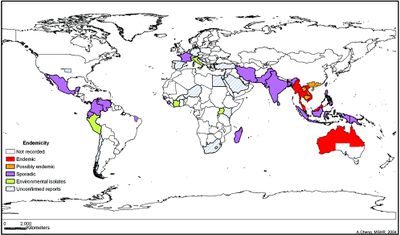Burkholderia pseudomallei infection: Difference between revisions
| Line 25: | Line 25: | ||
Transmission of <i>B. pseudomallei</i> regularly occurs through inhalation, ingestion or direct contact with contaminated soil or water. Innoculation of the organism usually occurs through skin abrasions. (MEDICINE.NET) Human-to-human transmission is very rare. Humans are not the only susceptible host to <i>B. pseudomallei</i>, other animals include: sheep, goats, swine, horses, cats, dogs and cattle. (CDC) | Transmission of <i>B. pseudomallei</i> regularly occurs through inhalation, ingestion or direct contact with contaminated soil or water. Innoculation of the organism usually occurs through skin abrasions. (MEDICINE.NET) Human-to-human transmission is very rare. Humans are not the only susceptible host to <i>B. pseudomallei</i>, other animals include: sheep, goats, swine, horses, cats, dogs and cattle. (CDC) | ||
===Infectious dose | ===Infectious dose and incubation period=== | ||
The infectious dose of <i>B. pseudomallei</i> is 10 colony forming units. (WADSWORTH.ORG) The incubation period of the organism varies, due to the type of infection and severity of infection. It may range from one day to many years (CDC). However, generally symptoms will appear two to four weeks after exposure to the bacterium. (CDC) | |||
===Epidemiology=== | ===Epidemiology=== | ||
[[File:Global_Distribution_Melioidosis.jpg|400px|thumb|right|Global distribution of Melioidosis. From: Allen C. Cheng [http://www.ncbi.nlm.nih.gov/pmc/articles/PMC1082802/]]] | [[File:Global_Distribution_Melioidosis.jpg|400px|thumb|right|Global distribution of Melioidosis. From: Allen C. Cheng [http://www.ncbi.nlm.nih.gov/pmc/articles/PMC1082802/]]] | ||
Revision as of 09:46, 26 July 2014

Etiology/Bacteriology
Taxonomy
| Domain = Bacteria
| Phylum = Proteobacteria
| Class = Betaproteobacteria
| Order = Burkholderiales
| Family = Burkholdiaceae
| Genus = Burkholderia
| species = B. pseudomallei
Description
Pathogenesis
Transmission
Transmission of B. pseudomallei regularly occurs through inhalation, ingestion or direct contact with contaminated soil or water. Innoculation of the organism usually occurs through skin abrasions. (MEDICINE.NET) Human-to-human transmission is very rare. Humans are not the only susceptible host to B. pseudomallei, other animals include: sheep, goats, swine, horses, cats, dogs and cattle. (CDC)
Infectious dose and incubation period
The infectious dose of B. pseudomallei is 10 colony forming units. (WADSWORTH.ORG) The incubation period of the organism varies, due to the type of infection and severity of infection. It may range from one day to many years (CDC). However, generally symptoms will appear two to four weeks after exposure to the bacterium. (CDC)
Epidemiology

Virulence Factors
Clinical Features
According the Center for Disease Control, there are four types of B. pseudomallei infections: localized, pulmonary, bloodstream, or disseminated. Localized infection usually presents as ulcer, nodule or skin abscess. These types of infections usually occur from the bacterium breaching through a break in the skin. Localized infection can result in fever or muscle aches in the area. Pulmonary infections are the most common form of infection and are often the hardest to diagnose because they can present as mild bronchitis or severe pneumonia. They are characterized by high fever, headache, anorexia and muscle soreness. Chest pain is also common with a pulmonary infection however; a nonproductive or productive cough with normal sputum is key for this type of infection. (CDC) In a bloodstream infection, patients may experience abdominal discomfort, joint pain, muscle tenderness, and disorientation. Abscesses may be found throughout the body especially in the liver, spleen or prostate. (CDC) With this type of infection symptoms are rapidly onset and patients with renal disease and diabetes are more susceptible to this type of infection.(CDC) In these patients, a bloodstream infection by B. pseudomallei usually results in septic shock. In a disseminated infection abscesses are common in the liver, spleen, lung and prostate. Other areas of the body included in this type of infection are the joints, bones, viscera, lymph nodes, skin and brain. Symptoms of this infection include: fever, weight loss, stomach or chest pain, muscle or joint pain, headaches, and seizures. (CDC) Infections by B. pseudomallei are often very serious as they can present in many different ways and can develop into kidney disease, blood disease, heart disease and more. (MST.EDU)
Diagnosis
Diagnosis of Melioidosis is best achieved through the isolation of the organism from a sample taken from the blood, sputum, skin lesion, abscess, or urine. (CDC) The bacteria can be isolated on the Ashdown medium first described by L.R. Ashdown in 1979. (CHENG) The medium contains: tryptase soy agar with glycerol, crystal violet, natural red, gentamicin and colistin. Gentamicin prevents the growth of other organisms, which allows the sample to be taken from non-sterile sites on the patient. (CHENG) Detection of an antibody response to the bacteria is also a form of diagnosis; however isolation of Burkholderia pseudomallei is more commonly used.
Treatment
The course of treatment for Melioidosis is subject to the severity and type of infection. The most common form of treatment begins with intravenous antimicrobial therapy for 10-14 days, followed directly by 3-6 months of oral antimicrobial therapy. (CDC) Two of the most common intravenous antimicrobial medications used are ceftazidime administered every 6-8 hours or meropenem administered every 8 hours. Trimethoprim-sulfamethoxazole or doxycycline may both be used for the oral antimicrobial therapy. (CDC) Alternative treatments are considered in cases of penicillin allergies. Treatment of B. pseudomallei is often dependent on the severity of the infection, as well as, the immunological health of the patient. Patients with diabetes or renal disease are often more susceptible to infection and therefore require a different course of treatment. In terms of respiratory infection, if abscesses develop on the lung after 6 months of positive culture on the lung a lobectomy is performed to remove the abscess. (MEDICINENET)
Prevention
Infection by Burkholderia pseudomallei in the endemic regions can be prevented by avoiding contact with soil and standing water, often the modes of transmission. Persons with open skin wounds or diabetes or chronic renal disease are at an increased risk for infection. In endemic areas, agricultural workers should wear boots to prevent infection through the feet and calf. (CDC) Health care professionals who may encounter the disease should take normal precautions.
Host Immune Response
References
Created by Rachel Garrison, student of Tyrrell Conway at the University of Oklahoma.
